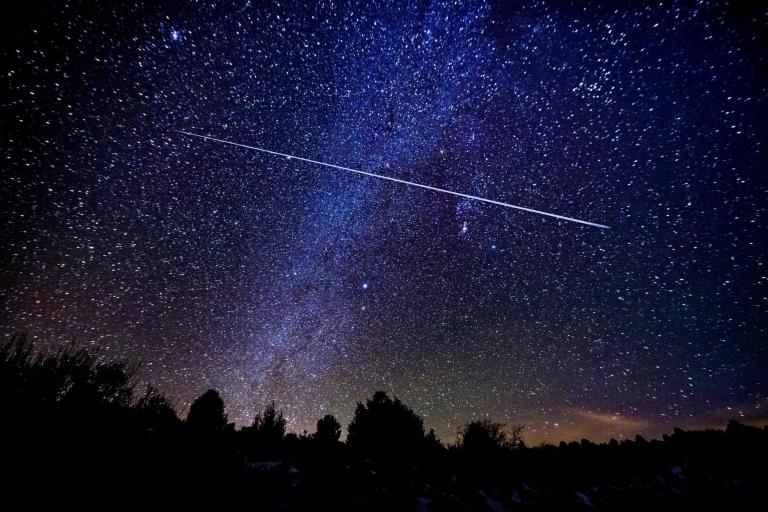This website uses cookies so that we can provide you with the best user experience possible. Cookie information is stored in your browser and performs functions such as recognising you when you return to our website and helping our team to understand which sections of the website you find most interesting and useful.

Just days into the New Year, star-watchers will be offered the first opportunity to glimpse a meteor shower - when the Quadrantids event lights up the night sky.
The Quadrantids meteor shower, active from December 28 to January 17, will be at its peak on the night of Thursday, January 3 and last into Friday morning - meaning those hoping to catch streaks of the meteors have just a few hours to do so.
According to NASA, the Quadrantids are best viewed in the Northern Hemisphere during the “night and predawn hours” and Space.com predicts the shower will start at 9pm ET or 7pm PT.
This is how to increase your chances of seeing the first meteor shower of the year
NASA first recommends finding a viewing area away from city or street lights.
Once you’ve found a location that isn’t hindered by lights, you should lay down with your “feet facing northeast and look up.”
According to NASA, it will take at least 30 minutes for your eyes to adjust to the night sky, at which point you will be able to see any meteors that are passing by.
It is also recommended that viewers skip binoculars as it can limit your vision field.
According to Space.com, the meteors will be most visible in the last hour before dawn.
To increase viewing chances further, viewers should look for the Bootes constellation, located near the end of the handle of the Big Dipper and focus attention there - as the meteors will appear to “radiation from the constellation.”
What you can expect to see
While meteor observer Robert Lunsford of the American Meteor Society told Space.com that meteor rates may be low, he predicts an “average viewing rate of about 11 sporadic meteors per hour.”
However, NASA suggests that during the peak, viewers may be able to see as many as 200 Quadrantid meteors per hour.
If you do happen to see a portion of the meteor shower, depending on weather conditions, you may see bright fireballs with glowing tails - originating from larger particles of material, according to NASA.
Why this meteor show is different than others
The Quadrantid meteor shower, which appears during December to early January each year, is different because, unlike most meteor showers which originate from comets, it originates from an asteroid - specifically asteroid 2003 EH1, according to NASA.
Created with Sketch.
Created with Sketch.
1/9 Spain
Hundreds of astronomy lovers enjoy the meteor shower in the aboriginal town of Atalayita in Canary Islands
EPA
2/9 Spain
A multiple exposure picture shows a Perseids meteor shower in the sky, near the municipality of La Hiruela, on the mountains of the Sierra Norte de Madrid
Getty Images
3/9 Spain
A shot of the Perseid meteor shower in 2008
Getty Images
4/9 Germany
Shooting star illuminates the night sky near Sieversdorf
EPA
5/9 Spain
A streak appears in the sky during the annual Perseid meteor shower above a roadside silhouette of a Spanish fighting bull, conceived decades ago in Spain as highway billboards, in Villarejo de Salvanes
AP
6/9 Hungary
A shooting star of the Perseids meteor shower burns up in the atmosphere in this photo taken near Salgotarjan, some 100km northeast of Budapest
EPA
7/9 Greece
In this photo taken with long shutter speed, a meteor sparks, lower right, while entering the earth's atmosphere behind an olive tree during the Perseids Meteor Shower, in Fanos village
AP
8/9 Spain
Stars and meteors are seen in a wide angle picture of the sky over Madrid
EPA
9/9 Spain
A multiple exposure picture shows a Perseids meteor shower in the sky, near the municipality of La Hiruela, on the mountains of the Sierra Norte de Madrid
Getty Images
1/9 Spain
Hundreds of astronomy lovers enjoy the meteor shower in the aboriginal town of Atalayita in Canary Islands
EPA
2/9 Spain
A multiple exposure picture shows a Perseids meteor shower in the sky, near the municipality of La Hiruela, on the mountains of the Sierra Norte de Madrid
Getty Images
3/9 Spain
A shot of the Perseid meteor shower in 2008
Getty Images
4/9 Germany
Shooting star illuminates the night sky near Sieversdorf
EPA
5/9 Spain
A streak appears in the sky during the annual Perseid meteor shower above a roadside silhouette of a Spanish fighting bull, conceived decades ago in Spain as highway billboards, in Villarejo de Salvanes
AP
6/9 Hungary
A shooting star of the Perseids meteor shower burns up in the atmosphere in this photo taken near Salgotarjan, some 100km northeast of Budapest
EPA
7/9 Greece
In this photo taken with long shutter speed, a meteor sparks, lower right, while entering the earth's atmosphere behind an olive tree during the Perseids Meteor Shower, in Fanos village
AP
8/9 Spain
Stars and meteors are seen in a wide angle picture of the sky over Madrid
EPA
9/9 Spain
A multiple exposure picture shows a Perseids meteor shower in the sky, near the municipality of La Hiruela, on the mountains of the Sierra Norte de Madrid
Getty Images
According to the space agency, the asteroid, which takes 5.2 years to orbit the sun once, may be a “dead comet” or an object called a “rock comet.”
If you aren’t able to view the Quadrantids meteor shower outside, you can watch it on NASA’s live stream, or wait for other upcoming meteor showers in 2019.



 Africana55 Radio
Africana55 Radio 

